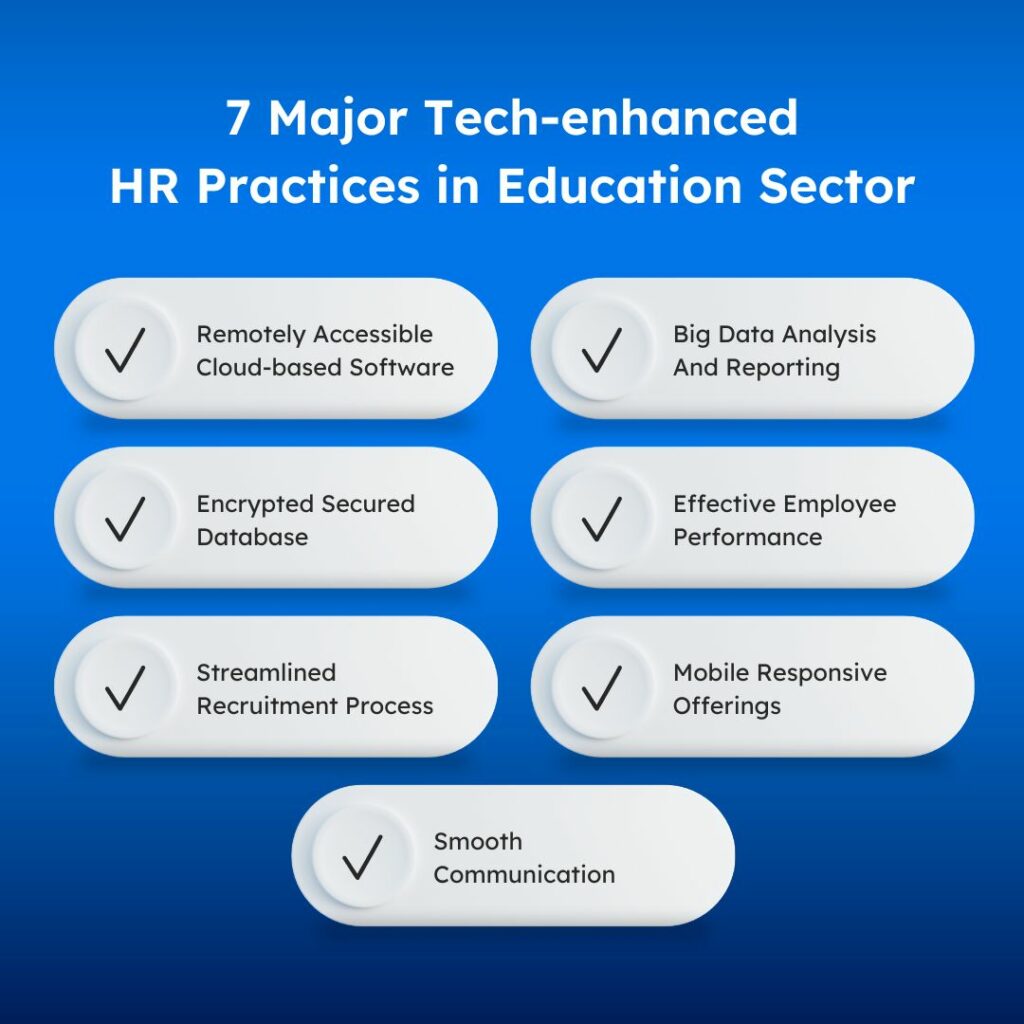Technology has helped streamline the standard administrative HR processes. With the help of technological innovations, the human resources department can manage the company’s employees with utmost efficiency. With technology, HR can capture accurate attendance data, efficiently undertake training, have an error-free employee database, and even keep their employees engaged.
All the factors mentioned above are applicable in the education sector too. In a domain where the common HR problems include a lack of a talented workforce, excessive administrative tasks, challenging retention, and inadequate training, having a one-stop solution like a Human Resources Management System (HRMS) is essential. If a tech-infused solution can help resolve all these issues, schools and educational institutions should start adapting HRMS soon.
Technology and HR Practices in Education

When it comes to the education sector, HR departments have traditionally been slow to adopt new technologies. However, to stay competitive in the changing job landscape, schools and colleges have started deploying HRMS solutions to increase the functional efficiency of their HR department.
Implementing technological solutions helps improve the legacy administrative work of the HR by augmenting their tasks. It also frees them from repetitive clerical tasks leaving them with more time to strategise and implement employee engagement activities. Keeping the academic staff engaged would help resolve talent shortage issues and help retain talent for longer.
Hence, let us check out the best tech-augmented HR practices in education:
Also Read: Recruitment of HRMS software in the Education Sector
Cloud Infrastructure
Cloud-based computing has made the implementation of professional applications effortless. Cloud software has multiple benefits when compared to its desktop and client-server counterparts. All these benefits lend themselves quickly in the HR domain, which is the main reason behind the rise in their popularity.
The HR in the education sector can also enjoy the numerous features of cloud-based software available via the Software-as-a-Service (SaaS) model. Round-the-clock remote access, automatic updates, data security, and no hardware dependency are some significant benefits of deploying the HRMS on the cloud. As a result, employee data such as salary, leave and attendance, performance and appraisal, etc., becomes easily accessible to the staff, improving their trust in their educational institution.
Big Data Analysis
Since data is the currency of the digital age, it is evident that organisations that effectively utilise their data have a significant advantage over others. Cloud-based systems often come with the additional processing power of the cloud infrastructure, which helps them process ‘Big Data’ and deduce actionable insights from it. Modern HRMS solutions are augmented with artificial intelligence that can observe historical information and provide predictive analysis to enhance the HR department’s productivity and data analysis capabilities.
Many decision-making processes can be simplified with the help of Big Data. Depending on the organisational goals and objectives, educational institutions can deduce valuable insights from the gathered data. With the use of cloud-based systems, collecting and analysing data become streamlined; hence, HRs and management can make strategic changes to their institution to provide better support to the employees and improve the employer brand.
Secure Database
With the advent of cloud-based HRMS, data security has ceased to be a concern for companies as the software vendor providing the services will ensure the safety of company and employee information. With military-grade encryption standards becoming industry practice to secure the company database, it becomes challenging for hackers to gain access and decrypt the data.
Additionally, cloud-based systems often have user access control which abstracts data by showing only the necessary information to the user based on their designation. Moreover, with a decentralised cloud-based HRMS, HRs can easily ensure that every employee is aware of the company policies.
Efficient Performance
Technology enables easy collection and analysis of employee data. It is especially relevant in the education sector, where performance reviews are more of an annual affair. However, with the help of a robust data-collection mechanism, one can have different kinds of data that can be used to analyse the performance of the employees. It can help understand the staff’s current morale, knowledge gaps, engagement rate, and more.
With effective use of technology, one can also develop customised rewards that enhance effectiveness. Similarly, HRMS can automatically suggest training programs based on the core competencies of an employee, thereby providing a meaningful addition to their skill set. Additionally, the software can also capture attendance and leave data, which is a crucial factor in deciding appraisals, making it an effective tool to ensure on-time reporting and avoid unplanned leaves.
Streamlined Recruitment
Recruitment is another area in which technology has vastly improved efficiency and workforce requirements. With modern technology, one can quickly post jobs online in minutes. Combined with the power of social media, you will be getting applications in no time. Additionally, even interviews can be conducted online with the help of chat and team platforms. Prospective candidates can even share their video resumes to make the process smoother and more efficient with technology.
Moreover, with the inclusion of an Applicant Tracking System (ATS) in the hiring process, sifting through resumes and shortlisting the relevant ones have become effortless, as it is entirely automated. HRs in the educational sector are effectively using modern technologies to provide virtual onboarding through the power of Augmented Reality (AR) and Virtual Reality (VR), both of which are relatively new technologies.
Mobile & Wearables
With the advent of SaaS-based technologies, mobile computing has taken a different paradigm altogether. Many HRMS allow employees to access their ESS portals from their smartphones with the help of a dedicated app. Similarly, software vendors have started implementing features related to wearable technology into the HRMS ecosystem. For example, approving or rejecting employee leaves from your smartwatch might seem overkill; however, managers love the feature.
While we are a few years from true wearables penetration in the HRMS tech space, it has enabled actual mobile-only access for a long time. The educational institutions that have deployed SaaS-based HRMS are enjoying the mobility and flexibility of mobile access. Their employees can apply for leaves, check and correct their information, download payslips and view the company policies any time they wish due to the dedicated mobile app.
Effortless Communication
Communication is an essential part of undertaking smooth everyday business in any institution. The same is true for educational establishments. Once again, technology aids in making it easier for it easier for everyone to communicate within the organisation. Modern HRMS have integrated chat platforms which provide rich text format, file-sharing options and even group chats for an intuitive experience.
New-age HRMS also notify employees of upcoming birthdays and anniversaries, which helps with team bonding. Moreover, it also informs them of new hires and promotions, as well as successful certifications of their colleagues, further cultivating a feeling of belonging to the work family. All these factors help foster an environment of belonging to a family and help the employee understand their value for their company.
Conclusion
Technology has revolutionised how the human resources department of schools and colleges conducts their daily business. Although these technological innovations are not exclusive to the education sector, it surely streamlines HR practices in the education sector.
Additionally, the tech-enhanced method of managing the academic and non-academic staff in educational institutions also results in improved morale, trust, and engagement with the company. Hence, more schools and other educational institutions are deploying new-age HRMS solutions to remediate talent shortages and employee retention issues.








